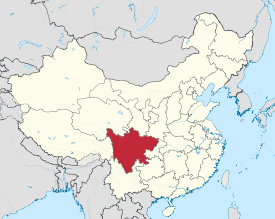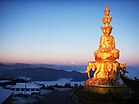Our website is made possible by displaying online advertisements to our visitors.
Please consider supporting us by disabling your ad blocker.
Sichuan
Sichuan
四川 | |
|---|---|
| Province of Sichuan | |
| Name transcription(s) | |
| • Chinese | 四川省 (Sìchuān shěng) |
| • Abbreviation | SC / 川 (Chuān) |
Clockwise: | |
 Location of Sichuan in China | |
| Country | China |
| Capital (and largest city) | Chengdu |
| Divisions | 21 prefectures, 181, 5011 |
| Government | |
| • Type | Province |
| • Body | Sichuan Provincial People's Congress |
| • Party Secretary | Wang Xiaohui |
| • Congress chairman | Wang Xiaohui |
| • Governor | Shi Xiaolin |
| • CPPCC chairwoman | Tian Xiangli |
| • National People's Congress Representation | 147 deputies |
| Area | |
• Total | 485,000 km2 (187,000 sq mi) |
| • Rank | 5th |
| Highest elevation | 7,556 m (24,790 ft) |
| Population (2020)[2] | |
• Total | 83,674,866 |
| • Rank | 5th |
| • Density | 170/km2 (450/sq mi) |
| • Rank | 22nd |
| Demographics | |
| • Ethnic composition | |
| • Languages and dialects | |
| GDP (2023)[3] | |
| • Total | CN¥6,013 billion (5th; US$853 billion) |
| • Per capita | CN¥71,835 (20th; US$10,194) |
| ISO 3166 code | CN-SC |
| HDI (2022) | 0.762[4] (22nd) – high |
| Website | www |
| Sichuan | |||||||||||||||||||||||||||||||||||||||||
|---|---|---|---|---|---|---|---|---|---|---|---|---|---|---|---|---|---|---|---|---|---|---|---|---|---|---|---|---|---|---|---|---|---|---|---|---|---|---|---|---|---|
"Sichuan" in Chinese characters | |||||||||||||||||||||||||||||||||||||||||
| Chinese name | |||||||||||||||||||||||||||||||||||||||||
| Chinese | 四川 | ||||||||||||||||||||||||||||||||||||||||
| Postal | Szechwan | ||||||||||||||||||||||||||||||||||||||||
| Literal meaning | "Four Plains" | ||||||||||||||||||||||||||||||||||||||||
| |||||||||||||||||||||||||||||||||||||||||
| Tibetan name | |||||||||||||||||||||||||||||||||||||||||
| Tibetan | སི་ཁྲོན་ | ||||||||||||||||||||||||||||||||||||||||
| |||||||||||||||||||||||||||||||||||||||||
| Yi name | |||||||||||||||||||||||||||||||||||||||||
| Yi |
| ||||||||||||||||||||||||||||||||||||||||
Sichuan[a] is a province in Southwestern China, occupying the Sichuan Basin and Tibetan Plateau—between the Jinsha River to the west, the Daba Mountains to the north, and the Yunnan–Guizhou Plateau to the south. Its capital city is Chengdu, and its population stands at 83 million. Sichuan neighbors Qinghai and Gansu to the north, Shaanxi and Chongqing to the east, Guizhou and Yunnan to the south, and Tibet to the west.
During antiquity, Sichuan was home to the kingdoms of Ba and Shu until their incorporation by the Qin. During the Three Kingdoms era (220–280), Liu Bei's state of Shu was based in Sichuan. The area was devastated in the 17th century by Zhang Xianzhong's rebellion and the area's subsequent Manchu conquest, but recovered to become one of China's most productive areas by the 19th century. During World War II, Chongqing served as the temporary capital of the Republic of China, and was heavily bombed. It was one of the last mainland areas captured by the People's Liberation Army during the Chinese Civil War, and was divided into four parts from 1949 to 1952, with Chongqing restored two years later. It suffered gravely during the Great Chinese Famine (1959–1961) but remained China's most-populous province until Chongqing was again separated from it in 1997.
The Sichuanese people speak distinctive dialects of Mandarin Chinese. The spicy Sichuan pepper is prominent in modern Sichuan cuisine, featuring dishes—including Kung Pao chicken and mapo tofu, that have become staples of Chinese cuisine around the world. There are many panda stations in the province and large reserves for these creatures, such as the Chengdu Research Base of Giant Panda Breeding.
Sichuan is the 6th-largest provincial economy of China, the largest in Western China, and the second-largest among inland provinces after Henan. As of 2021, its nominal GDP was CN¥5,385 billion (US$847.68 billion), ahead of that of Turkey ($815 billion).[6][7] If it were its own country, Sichuan would be the 18th-largest economy and 19th-most populous as of 2021.[8]
- ^ "Doing Business in China – Survey". Ministry Of Commerce, People's Republic Of China. Archived from the original on 26 May 2014. Retrieved 5 August 2013.
- ^ "Communiqué of the Seventh National Population Census (No. 3)". National Bureau of Statistics of China. 11 May 2021. Archived from the original on 1 October 2021. Retrieved 11 May 2021.
- ^ "regional - annual by province - national accounts - gross regional product" (Press release). China NBS. Retrieved 13 May 2023. see also 2023年四川省国民经济和社会发展统计公报 (in Chinese). sichuan.gov.cn. 14 March 2024. Retrieved 19 June 2024.
- ^ "Human Development Indices (8.0)- China". Global Data Lab. Retrieved 23 September 2024.
- ^ "Sichuan". Lexico UK English Dictionary. Oxford University Press. Archived from the original on 13 January 2021.
- ^ "Decoding China's 2021 GDP Growth Rate: A Look at Regional Numbers". China Briefing News. 7 February 2022. Archived from the original on 19 August 2022. Retrieved 15 September 2022.
- ^ "GDP Turkiye". World Bank. Archived from the original on 15 September 2022. Retrieved 15 September 2022.
- ^ "GDP Data". data.worldbank.org. Archived from the original on 15 September 2022. Retrieved 15 September 2022.
Cite error: There are <ref group=lower-alpha> tags or {{efn}} templates on this page, but the references will not show without a {{reflist|group=lower-alpha}} template or {{notelist}} template (see the help page).
Previous Page Next Page







